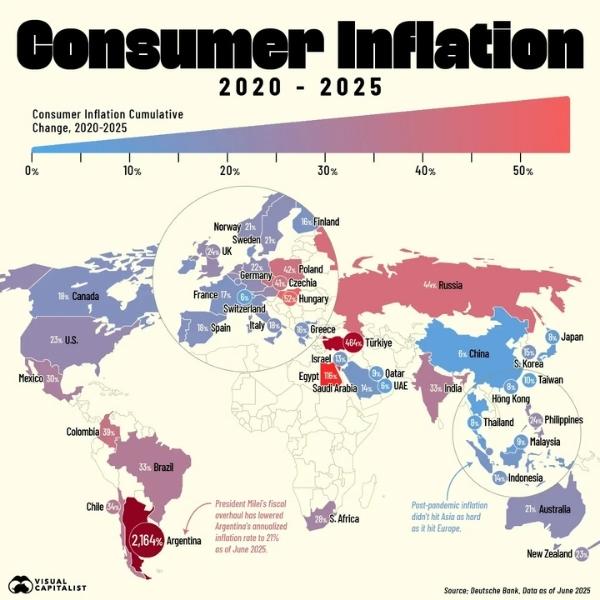Think of inflation the way you think of Goldilocks and the Three Bears: too much or too little is a problem. Just a bit can be just right.

Sign at a market tells consumers they will get less for more. (Illustration by News Decoder)
Editor’s note: On 14 October, the head of J.P. Morgan, one of the world’s largest investment banks, warned of a ripple effect from the collapse of the private credit market in the United States as some providers of car loans announced they were going under.
This sparked fears of larger and global financial troubles caused by inflation; a rapid rise in prices of goods mean that many people can’t afford to buy products which leads to a cycle of business failures and job losses. Our own Educational News Director just came back from a trip to the United States where she was shocked by the price of food.
To help our readers understand how inflation can affect both personal budgets and national economies, we decided to republish an article by correspondent Alan Wheatley, first published in February 2018, that explains how inflation works and how it isn’t necessarily bad.
We launched Decoder Replay to help readers better understand current world events by seeing how our correspondents decoded similar events in the past.
What policymakers want is inflation that, like Goldilocks’s porridge, is just right. For central banks in rich countries, that means consumer prices rising at a rate of about 2 percent a year.
Stable inflation is good for economic confidence. If businesses and households can count on prices being just a bit higher in a year’s time, they can budget to increase investment or replace their ageing car.
A little inflation is especially welcome after a period of economic weakness because it lifts profits and encourages businesses and households to borrow money and spend it more quickly.
But high and accelerating inflation plays havoc with long-term investment and lending plans because accurate forecasting becomes impossible. People on fixed incomes, such as pensioners, see their purchasing power eroded. The economy becomes distorted as consumers rush to buy things before prices rise even further.
The chances of inflation getting out of control are small.
Falling inflation — or an outright decline in prices, known as deflation — is equally problematic. That’s because people hold off buying that new car knowing it can only become cheaper. As demand in the economy drops, workers are laid off. Overall spending power shrinks further, in a vicious circle.
Although prices may fall, the face value of debt does not. So the real burden of servicing a company loan, a government bond or a household mortgage grows heavier and heavier, reducing disposable incomes and tightening the squeeze on the economy.
That’s why central banks have gone to extraordinary lengths in the past decade to banish the specter of deflation. They’ve succeeded. Indeed, stock markets have been rattled by evidence that inflation is stirring in the United States, which might prompt the Federal Reserve to raise interest rates more rapidly than previously thought.
(On Wednesday, the U.S. government reported that consumer prices rose by 0.5 percent in January, more than expected. “Core” prices excluding volatile food and energy costs marked the biggest monthly gain in a year.)
But the chances of inflation getting out of control are small.
First, companies operate globally, so if manufacturing costs rise too high in the United States, they will shift production to cheaper locations overseas.
Second, there is still slack in the U.S. jobs market because many people who gave up looking for work after the crisis could be lured back into employment, capping wages.
Third, there is no reason to believe the Fed — or financial markets for that matter — would allow the money supply to spiral out of control.
The United States is no Venezuela.
Prices rise and fall all the time in response to factors such as changing consumer tastes and technological innovation. Medical care costs a lot more than in the past, computers a lot less. But a generalized rise in prices across the economy — which is the definition of inflation — is possible only if a country’s central bank prints too much money.
That’s what’s happened in Venezuela, where the money supply has increased by 4,000 percent in the past two years. The result is hyperinflation, forecast by the International Monetary Fund to reach 13,000 percent this year. Goldilocks’s oatmeal is nearly doubling in price every month. Poverty is rife because wages lag price rises. The economy is on its knees.
The United States is no Venezuela. Evidence of a pick-up in wages is good news in fact, considering that workers have been taking home less and less of the economic pie in recent years, while the suppliers of capital have benefited handsomely.
It’s possible that the recently enacted package of U.S. tax cuts and spending increases will cause the economy to run a bit too hot, pushing up prices a bit. But of the many problems facing the U.S. economy, runaway inflation is not one of them.
In 1981, then Fed Chairman Paul Volcker had to raise short-term U.S. interest rates to 20 percent to crush inflation. History will not need to repeat itself.
Questions to consider:
1. What “ripple effect” could a rise in consumer prices cause?
2. How can inflation be good?
3. When prices go up significantly, what might you or your family not buy?

Alan Wheatley is an economics writer and editor based in London. Until recently, he was Reuters’s global economics correspondent, reporting from more than 40 countries and living in London, Frankfurt, Paris, New York, Washington, Tokyo, Singapore and Beijing. He is co-author of the book The Power of Currencies, Currencies of Power, which explores the consequences of looming challenges to the dollar’s status as the world’s leading reserve currency.

